Click on images to enlarge
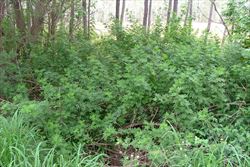
infestation (Photo: Sheldon Navie)
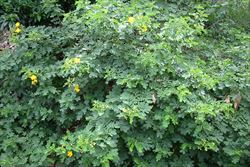
habit (Photo: Sheldon Navie)
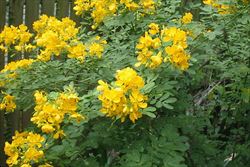
habit in flower (Photo: Sheldon Navie)
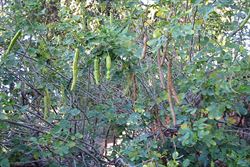
habit in fruit (Photo: Sheldon Navie)
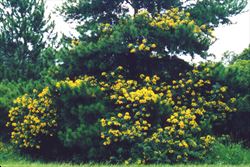
climbing habit (Photo: Land Protection, QDNRW)
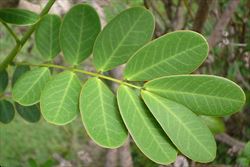
once-compund leaf with broad leaflets that have prominent yellowish-coloured margins (Photo: Sheldon Navie)
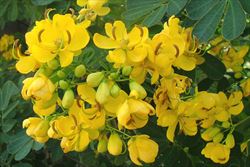
flowers (Photo: Sheldon Navie)
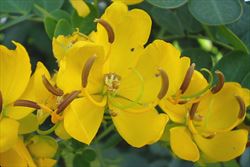
close-up of flowers (Photo: Sheldon Navie)
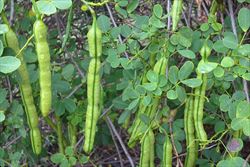
immature fruit (Photo: Sheldon Navie)

mature fruit (Photo: Sheldon Navie)
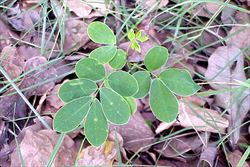
seedling (Photo: Sheldon Navie)
Scientific Name
Senna pendula (Willd.) Irwin & Barneby var. glabrata (Vogel) Irwin & Barneby
Synonyms
Cassia bicapsularis L. (misapplied)Cassia cotuleoides ColladonCassia indecora Kunth var. glabrata Vogel
Family
Caesalpiniaceae (Queensland, the ACT, Victoria, Tasmania, Western Australia and the Northern Territory)Fabaceae: sub-family Caesalpinioideae (New South Wales)Leguminosae (South Australia)
Common Names
climbing cassia, Easter cassia, senna, winter senna
Origin
Native to tropical South America (i.e. Brazil and Paraguay).
Cultivation
Widely cultivated as a garden ornamental, particularly in the wetter coastal districts of Australia.
Naturalised Distribution
A widely distributed species that has mainly become naturalised in the eastern parts of the country. It is most common in the coastal and sub-coastal regions of south-eastern Queensland and New South Wales. Also present in other parts of Queensland and recorded in Victoria.
naturalised in south-eastern, central and northern Queensland - naturalised in many parts of eastern NSW (particularly in coastal districts) - naturalised on Lord Howe Island.
Habitat
A weed of waterways, gardens, disturbed sites, waste areas, roadsides, closed forests, forest margins and urban bushland in tropical, sub-tropical and warmer temperate regions.
Habit
An erect (i.e. upright), spreading or sprawling shrub usually growing 2-4 m tall, but occasionally reaching up to 5 m in height.
Distinguishing Features
- an erect or sprawling shrub usually growing 2-4 m tall.
- its stems are much-branched and its once-compound leaves have three to six pairs of leaflets.
- these broad leaflets (1-5 cm long and 5-20 mm wide) have rounded tips and prominent yellowish margins.
- its bright yellow flowers (about 3 cm across) have five large petals and are borne in leafy clusters at the tips of the branches.
- its fruit are cylindrical pods (10-20 cm long and 6-12 mm wide) that hang downwards.
Stems and Leaves
The stems are much-branched and become woody with age. Younger stems are green in colour and sparsely hairy (i.e. puberulent), but become hairless (i.e. glabrous) and darker as they mature.
The compound (i.e. pinnate) leaves (4-8 cm long) are alternately arranged along the stems and borne on stalks (i.e. petioles) 20-40 mm long. They have three to six pairs of dark green leaflets with rounded tips (i.e. obtuse apices). These leaflets are egg-shaped in outline (i.e. obovate) or oval (i.e. elliptic) in shape, with those closer to the stem generally being smaller than those at the tip of the leaves (10-50 mm long and 5-20 mm wide). They are almost hairless (i.e. glabrous) with quite prominent entire margins that are yellowish in colour. There is a small cone-shaped (i.e. conical) gland in between the two lowest leaflets of each leaf (i.e. on the rachis).
Flowers and Fruit
The flowers are bright yellow (about 30 mm across) with five large petals (20-25 mm long). They are borne in leafy clusters at the tips of the branches, and each has a stalk (i.e. pedicel) about 20-30 mm long. These flowers have two or three prominent stamens that are curved, four or five smaller stamens (i.e. six or seven in total), and three tiny petal-like structures (i.e. staminodes) at their centres. Flowering occurs throughout the year, but is most prevalent during autumn (i.e. at Easter time).
The fruit are cylindrical pods (10-20 cm long and 6-12 mm wide) that hang downwards (i.e. they are pendulous). These fruit turn from green to pale brown in colour as they mature, contain numerous (5-40) black seeds, and often have irregular constrictions.
Reproduction and Dispersal
This plant reproduces by seeds.
Seeds are often dispersed in dumped garden waste. They may also be spread by water or in contaminated soil.
Environmental Impact
Easter cassia (Senna pendula var. glabrata) is regarded as a significant environmental weed in New South Wales and Queensland. It was recently listed as a priority environmental weed in two Natural Resource Management regions, and is actively managed by community groups in Queensland.
Legislation
This species is declared under legislation in the following states and territories:
- New South Wales: Class 4 - a locally controlled weed. The growth and spread of this species must be controlled according to the measures specified in a management plan published by the local control authority and the plant may not be sold, propagated or knowingly distributed (in the Manly, Ryde and Willoughby local authority areas).
- Western Australia: Unassessed - this species is declared in other states or territories and is prohibited until assessed via a weed risk assessment (throughout the entire state).
Management
For information on the management of this species see the following resources:
- the Biosecurity Queensland Fact Sheet on this species, which is available online at http://www.dpi.qld.gov.au.
Similar Species
Easter cassia (Senna pendula var. glabrata) is very similar to coffee senna (Senna occidentalis), sicklepod (Senna obtusifolia), Java bean (Senna tora), hairy senna (Senna hirsuta), smooth senna (Senna septemtrionalis) and the native arsenic bush (Senna planitiicola). It is also relatively similar to pepper-leaved senna (Senna barclayana). These species can be distinguished by the following differences:
- Easter cassia (Senna pendula var. glabrata) is a moderately-sized shrub (2-4 m tall) that has leaves with several (3-6) pairs of leaflets. The moderately-sized leaflets (20-50 mm long) are relatively broad (10-20 mm wide) with rounded tips (i.e. obtuse apices) and prominent yellowish coloured margins. Its flowers are borne in relatively loose leafy clusters and its elongated (10-20 cm long) pods are almost rounded in cross-section (i.e. cylindrical) and relatively thick (8-12 mm wide). These pods are relatively straight, sometimes have one or more constrictions, and are hairless (i.e. glabrous).
- coffee senna (Senna occidentalis) is a relatively small slender shrub (usually 0.5-2 m tall) that has leaves with several (3-7) pairs of leaflets. The relatively large leaflets (30-100 mm long) are relatively broad (20-40 mm wide) and have pointed tips (i.e. acute apices). Its flowers are borne in small clusters in the leaf forks and its very elongated (7.5-13 cm long) pods are rounded (i.e. cylindrical) or slightly flattened and relatively thick (6-11 mm wide). These pods are straight or slightly-curved upwards and are mostly hairless (i.e. glabrous).
- hairy senna (Senna hirsuta) is a relatively small slender shrub (usually 0.5-2 m tall) that has leaves with several (2-6) pairs of leaflets. These relatively large leaflets (40-105 mm long) are relatively broad (20-40 mm wide) and have pointed tips (i.e. acute apices). Its flowers are borne in small clusters in the leaf forks and its very elongated (10-18 cm long) pods are usually somewhat flattened and very narrow (4-6 mm wide). These pods are slightly-curved downwards and are densely covered in long white hairs (i.e. pubescent).
- sicklepod (Senna obtusifolia) is a relatively small slender shrub (usually 0.5-2 m tall) that has leaves with a few (2-3) pairs of leaflets. The relatively large leaflets (17-65 mm long) are relatively broad (15-40 mm wide) and have rounded tips (i.e. obtuse apices). Its flowers are borne in pairs in the leaf forks and the very elongated (6-18 cm long) pods are almost rounded in cross-section (i.e. cylindrical) and very narrow (2-6 mm wide). These pods are strongly curved downwards (i.e. sickle-shaped) and are mostly hairless (i.e. glabrous).
- Java bean (Senna tora) is a relatively small slender shrub (usually 0.5-2 m tall) that has leaves with a few (2-4) pairs of leaflets. The moderately-sized leaflets (10-40 mm long) are relatively broad (10-35 mm wide) and have rounded tips (i.e. obtuse apices). Its flowers are borne in pairs in the leaf forks and its very elongated (12-25 cm long) pods are almost rounded in cross-section (i.e. cylindrical) and very narrow (2-6 mm wide). These pods are strongly curved downwards (i.e. sickle-shaped) and are mostly hairless (i.e. glabrous). This species also gives off a strong unpleasant smell.
- smooth senna (Senna septemtrionalis) is a moderately-sized shrub (1-3 m tall) that has leaves with several (3-5) pairs of leaflets. The relatively large leaflets (45-70 mm long) are relatively broad (15-35 mm wide) and have pointed tips (i.e. acute apices). Its flowers are borne in relatively loose and somewhat elongated clusters (i.e. racemes) and its elongated (6-10.5 cm long) pods are almost rounded in cross-section (i.e. cylindrical) and relatively thick (10-15 mm wide). These pods are straight and mostly hairless (i.e. glabrous).
- arsenic bush (Senna planitiicola) is a relatively small slender shrub (usually 0.5-2 m tall) that has leaves with several (5-7) pairs of leaflets. The moderately-sized leaflets (25-50 mm long) are relatively broad (15-25 mm across) and have somewhat pointed tips (i.e. acute apices). Its flowers are borne in small clusters in the leaf forks and its relatively short (less than 8.5 cm long) pods are almost rounded in cross-section (i.e. cylindrical) and relatively thick (8-11 mm wide). These pods are straight and mostly hairless (i.e. glabrous).
- pepper-leaved senna (Senna barclayana) is a low-growing shrub (usually less than 1 m tall) that has leaves with several (4-10) pairs of leaflets. The moderately-sized leaflets (20-50 mm long) are relatively narrow (4-15 mm wide) and have pointed tips (i.e. acute apices). Its flowers are borne in small clusters in the leaf forks and its relatively short (3-7 cm long) pods are almost rounded in cross-section (i.e. cylindrical) and relatively thick (6-9 mm wide). These pods are straight and hairless (i.e. glabrous).

